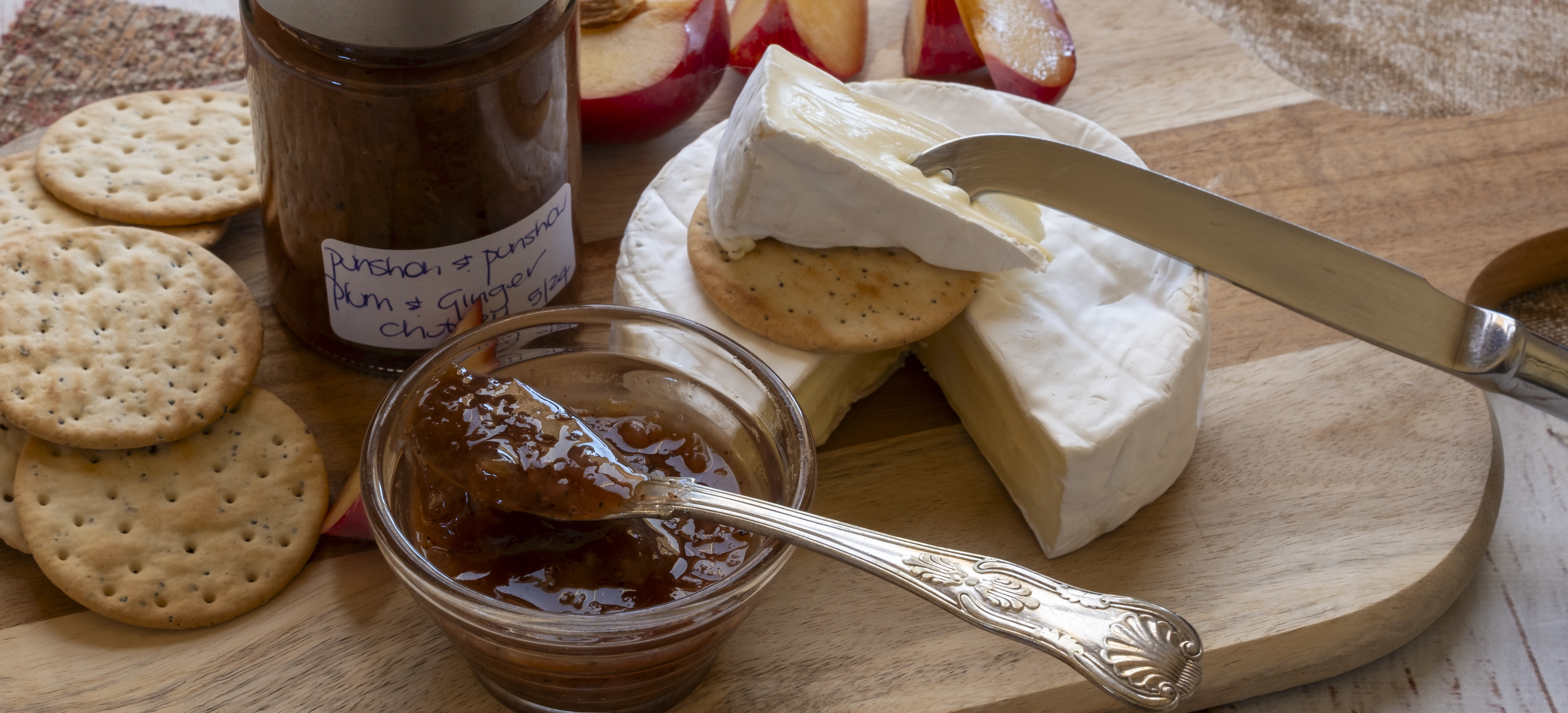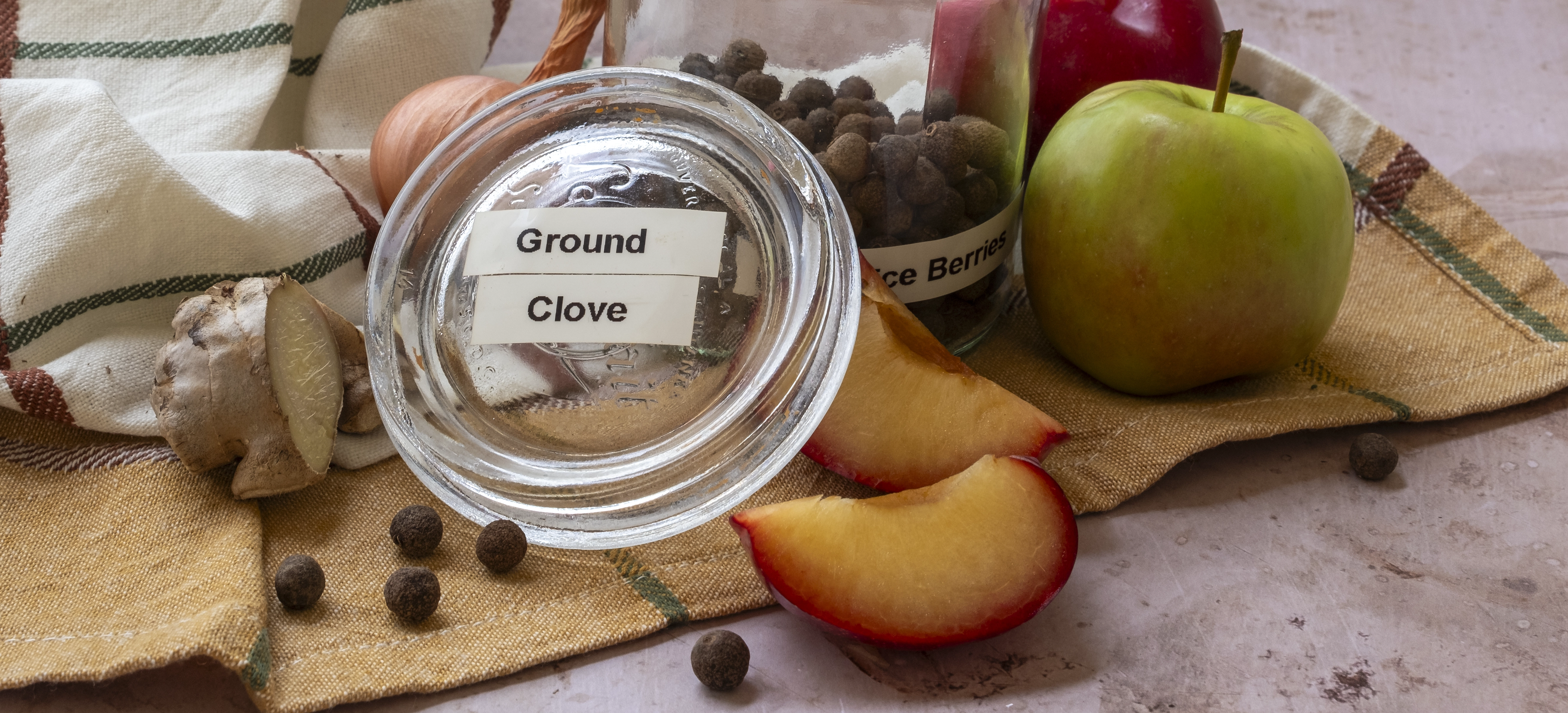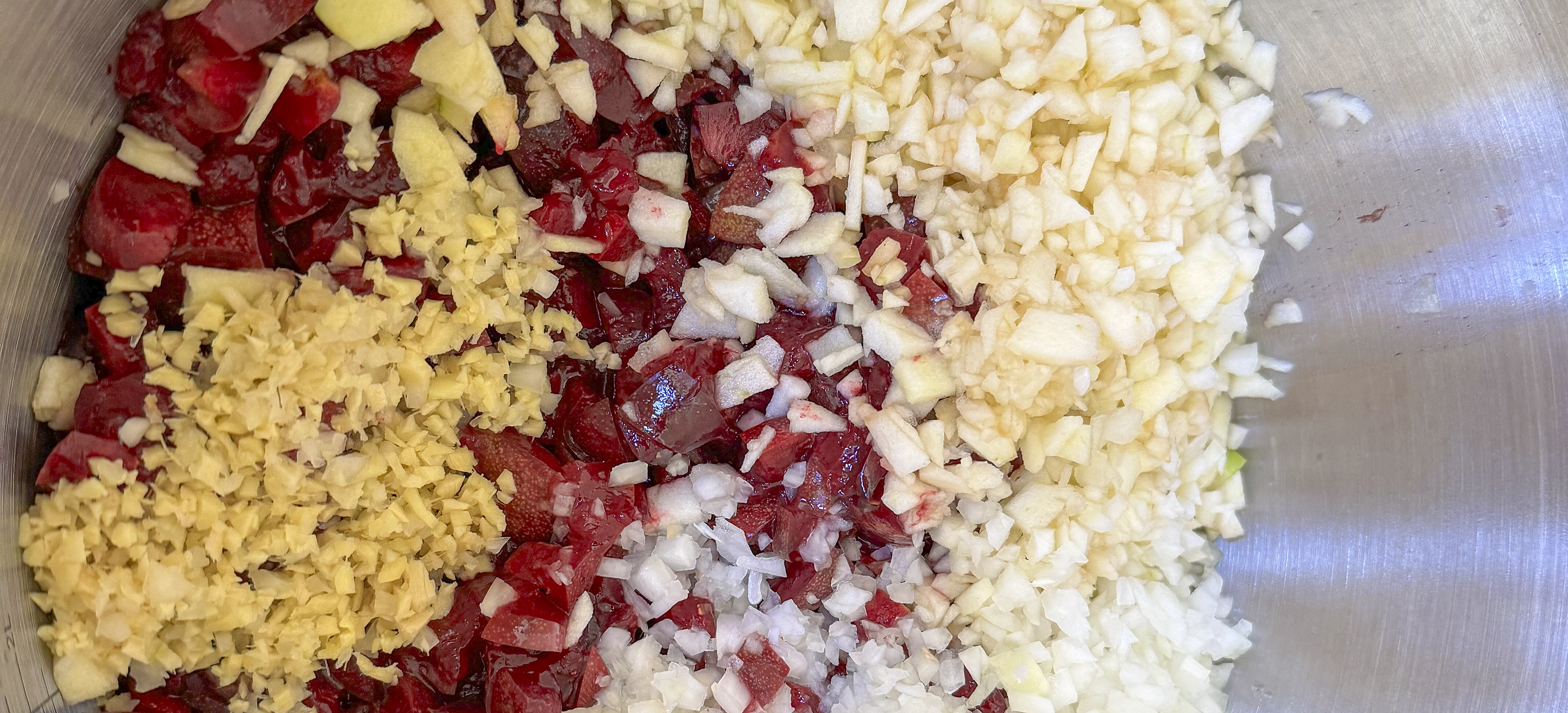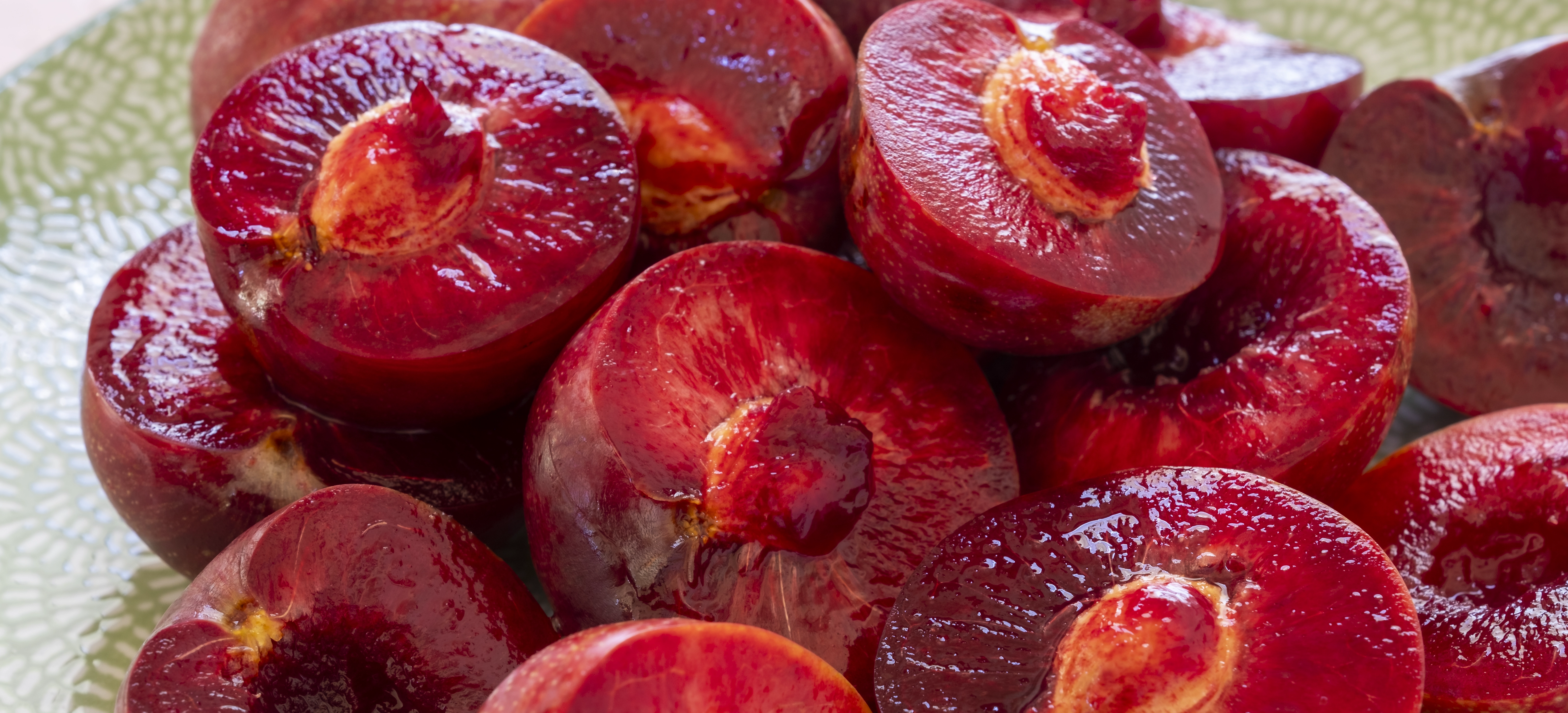Plum & Ginger Chutney
- Pickles, Chutney, Relish & Sauces

The naturally intense flavour of plums combined with ginger, allspice and clove produces an alluring chutney. It has a tarty sweetness with Christmas pudding spice undertones that makes it a perfect partner with rich meats, dry sharp cheese and strong soft cheese such as goats and feta. This recipe couldn’t be simpler. There’s no complicated steps just dice, mix and simmer, then jar up. An ideal chutney for preservers commencing their journey and the perfect addition to the repertoire of the more experienced. Enjoy!
- Preparation Time:
- 30 minutes
- Cooking Time:
- 60 minutes
- Quantity:
- 7 x 300ml jars
PREPARATION
Have hot sterilised glass jars and lids with a protective lining ready

INGREDIENTS
- 1 kg
- Dark plums, prepared
- 500g
- Granny Smith apple, prepared
- 1
- Onion, brown
- 30g
- Ginger, fresh
- 180g
- White sugar
- 180g
- Soft brown sugar
- 250 ml
- Apple cider vinegar
- 1 teaspoon
- Allspice, ground
- 1 teaspoon
- Clove, ground
- 1/2 teaspoon
- Salt

METHOD
Gently wash and dry the plums and the green apples to remove any shop or garden dust and/or debris. Leaving the skin on, remove the stone, cut the plums in half and coarsely chop. Peel and core the apple and chop it into 5-8 mm cubes. Discard the plum stones and apple peel and cores.
Peel the brown onion chop into pieces - the same size as the apple. Peel the fresh ginger and grate or finely chop.
Place prepared plums, apple, onion, and ginger into a large stainless steel preserving pan or large heavy bottom stainless steel pot. Add the vinegar, white and brown sugar, ground allspice, clove, and salt.
Place the pan on medium heat. Stir occasionally until the sugar has completely dissolved.
Bring to the boil and then reduce the heat and simmer gently, without the lid, for 1- 1¼ hours or until the mixture is thick.
Stir occasionally while simmering and then more frequently towards the end as the chutney thickens.
Meanwhile, sterilize jars and non-metallic, vinegar-proof lids. Time this process so that the jars and lids are still hot at the chutney bottling stage.
When the chutney has thickened, remove from the heat and place on a heat resistant surface. Allow to rest for 5 minutes.
Using a funnel, pour into hot dry sterilised screw cap sealable jars. Fill to approximately 2.5cm (1inch) from the top, seal with hot dry lids while the chutney is hot.
-
Label and store in a cool dark place in the kitchen or pantry.
Allow the chutney to mature for at least 2 weeks, preferably 4 weeks, before eating.
NOTES
- Red or yellow plums can be used for this recipe. When using the yellow plums ( the internal colour), the final colour will not have the same dark and intense red colour as when using the red plums (internal colour). However, its still delicious.
- Choose clean ripe fruit. Do not use overripe and never use mouldy fruit as this will produce a poor-quality chutney.
- If you want a chunkier chutney texture, cut the fruit into larger pieces. If there are several types of fruit, consider cutting them into similar sizes. Onion should be cut smaller.
- Good quality jars should be used in preserving, particularly when they are processed in a hot water bath. Thin jars often cannot withstand the temperatures and may crack either in the bath or on and or after removal. Avoid the disappointment and invest in some good jars from a homewares or preserves outlet. Select jars that have non-reactive lids as the vinegar solution can cause the lids to rust over time.
- The type and colour of the sugar and vinegar used will affect the final colour and flavour of the chutney. Malt vinegar and brown sugar will produce very dark brownish chutney with a more earthy/molasses background flavour. White wine or apple cider vinegar and white sugar will allow the fresh fruit flavour to come through. I use a combination of white and brown sugar with apple cider vinegar in this recipe to add a little more depth of flavour while keeping a fresh fruity plum flavour.
- Cooking times are an approximation only. They are provided as a guideline as cooking times are influenced by the type of pot and its diameter and height, speed of cooking and fruit ripeness, size , and moisture level. Cooking time will depend upon:
- The size of preserving pan - the broader the pan the quicker the evaporation
- Degree of fruit ripeness – the riper the fruit, the sweeter and juicier the initial chutney will be
- The degree of heat when cooking – the higher the heat, the greater the boil which will produce greater evaporation:
- To test the chutney is cooked to the right consistency, spoon a little of the mixture on to a plate. It should hold its shape.
- Do not place a lid on the pan while cooking the chutney. Cooking it uncovered allows evaporation which helps to thicken the chutney.
- Towards the end of the cooking process, it may be necessary to stir regularly. It is important that the fruit does not stick to the bottom of the pan and burn. Your chutney will be tainted with a burnt flavour which is not very pleasant.
- Always store chutney in a cool dark place. A warm area can cause it to ferment, and bright sunlight can affect the colour.
- Chutneys are best left to mature for 2 months in a cool dark place before eating. Traditionally they were stored in the cellar or pantry.
- KNOWING YOUR SPICES
- Allspice (Pimenta diocia)
- Also known as Jamaican pepper, clove pepper, pimento
- Allspice comes from an evergreen tree in the myrtle family. Twigs bearing the berries are picked in summer when the berries are mature but still green. Berries are sweated in containers to release their active ingredients then dried.
- Whole berries retain their flavour well and will keep almost indefinitely if sealed and stored in a cool dark place. Their rough surface contains tiny oil glands and most of the flavour is contained in the wrinkled husk, not the seeds.
- Allspice powder quickly loses potency. Best to buy in small quantities and keep sealed in cool dark place for up to 6 months.
- Clove (Syzygium aronaticum)
- Cloves are the dried unopened flower buds of a tropical evergreen plant. Borne in a cluster of 10-15, they are picked when full size, still green but just on the verge of turning pink.
- Aroma is pungent, warm, aromatic, camphor-like and faintly peppery. The flavour is intensely pungent. Words like medicinal warming sweeter, lingering and numbing come to mind. It is usually tamed by blending with other similar warming spices to soften its dominance. Use sparingly.
- Used in moderation, cloves bring a pleasing, palate-cleansing freshness, and sweet spicy flavour to food.
- Look for cloves that are plump, not shriveled or broken and where the majority retain their rounded tops.
- Ginger (Zingiber officinale)
- Ginger has a hot-spice, citrusy woody taste. It’s available as a fresh underground stem, a rhizome, as a finely ground powder and preserved in sugar.
- The dried and preserved version is used in baking and in spice blends whereas fresh ginger is used widely in Asian cuisine.
- Do not substitute dried ginger for fresh as the dried form has a stronger and more aromatic flavour. When purchasing fresh ginger, avoid older rhizomes with signs of shrivelling as it is drying out and the flesh can be fibrous.
- Salt
- Use good quality pickling salt when making pickles and preserves. Many commercial salt brands contain stabilisers and anti-caking agents and often iodide which forms a whitish haze and sediment. These additives and in particular iodine can affect the appearance and taste of pickles and preserves during the maturation and storage period.
- The ingestion of a cocktail of anti-caking chemicals such as calcium silicate, sodium silicoaluminate, tricalcium phosphate, magnesium carbonate, silicon dioxide and yellow prussate of soda, is also unnecessary.
- Read the label before buying and look for salt that is free from any artificial additives. My favourite salt is Olsson Cooking Salt. No commercial benefit is received from Olsson Salt.

